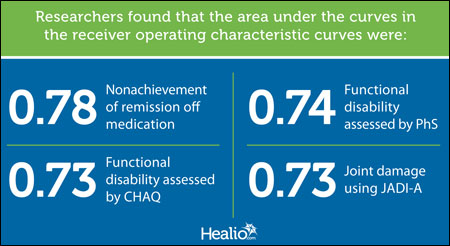Baseline Assessment Can Predict Long-term JIA Outcomes
Making long-term outcome predictions of remission off medication, functional disability and joint damage may be feasible in juvenile idiopathic arthritis based on early clinical assessment, according to findings published in Arthritis Research and Therapy.
“The primary goal of [juvenile idiopathic arthritis (JIA)] treatment is to achieve remission,” Veronika Rypdal, MD, of the University Hospital of North Norway, and colleagues wrote. “Early prediction of the disease course for the individual child can facilitate tailored treatment. There is increasing evidence for the concept of ‘the window of therapeutic opportunity’ in JIA, where early aggressive treatment with biologic agents and/or other disease-modifying anti-rheumatic drugs (DMARDs) may modify the disease course and improve long-term prognosis. On the other hand, it is also essential to avoid unnecessary, costly, and potentially toxic treatment in children with a favorable prognosis.”
To develop a set of prediction rules that may guide early treatment decisions in JIA, the researchers drew data from the initial Nordic JIA cohort, a prospective, longitudinal group of consecutive children from 12 centers in Denmark, Finland, Norway and Sweden. The researchers focused on 440 children with baseline and final study visits, with the latter occurring 8 years following disease onset. Of those, 423 were included in the final study cohort, after 17 with systemic JIA were excluded.

At the follow-up visit, the researchers evaluated four outcomes. Rypdal and colleagues included nonachievement of remission off medication, according to the preliminary Wallace criteria; functional disability assessed by Childhood Health Assessment Questionnaire (CHAQ); functional disability as defined by the Physical Summary Score (PhS) of the Child Health Questionnaire; and articular damage as assessed by the Juvenile Arthritis Damage Index-Articular (JADI-A). The researchers performed cross-validations through repeated partitioning of the cohort into training sets for developing prediction models and validation sets to test predictive ability.
According to study findings, among the 410 children with available remission-status data, 59.9% failed to achieve remission off medication as of the final visit. In addition, functional disability was present in 32.7% of the 340 children assessed by CHAQ, and in 20.1% of the 199 evaluated through PhS. Joint damage was found in 13.4% of the 216 children assessed by the JADI-A. The researchers found that model performance was acceptable for making long-term outcome predictions, they wrote.
In their validation sets, the researchers found that the area under the curves in the receiver operating characteristic curves were 0.78 (interquartile range [IQR]: 0.72-0.82) for nonachievement of remission off medication; 0.73 (IQR: 0.67-0.76) for functional disability assessed by CHAQ; 0.74 (IQR: 0.65-0.8) for functional disability assessed by PhS; and 0.73 (IQR: 0.63-0.76) for joint damage using JADI-A.
“We have developed statistical models for predicting nonachievement of remission off medication, functional disability and joint damage in children with JIA,” Rypdal and colleagues wrote. “The models are easy to use and may provide a valuable tool to aid early treatment decisions on the need for DMARDs including biologic agents if validation in other JIA cohorts and across ethnicities can confirm our results. We encourage further testing of our models before the applicability can be generalized and recommended.” – by Jason Laday

Disclosure: Rypdal reports no relevant financial disclosures. Please see the full study for additional researchers’ relevant financial disclosures.
